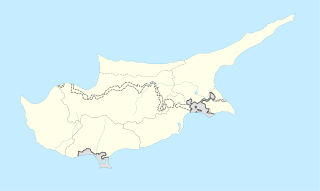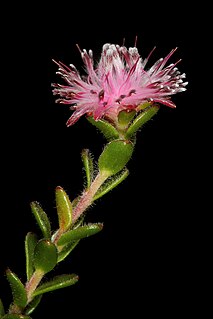
The Ericaceae are a family of flowering plants, commonly known as the heath or heather family, found most commonly in acid and infertile growing conditions. The family is large, with c. 4250 known species spread across 124 genera, making it the 14th most species-rich family of flowering plants. The many well-known and economically important members of the Ericaceae include the cranberry, blueberry, huckleberry, rhododendron, and various common heaths and heathers.

The flowering plants, also known as Angiospermae, or Magnoliophyta, are the most diverse group of land plants, with 64 orders, 416 families, approximately 13,000 known genera and 300,000 known species. Like gymnosperms, angiosperms are seed-producing plants. They are distinguished from gymnosperms by characteristics including flowers, endosperm within their seeds, and the production of fruits that contain the seeds. Etymologically, angiosperm means a plant that produces seeds within an enclosure; in other words, a fruiting plant. The term comes from the Greek words angeion and sperma (seed)

Parsley or garden parsley is a species of flowering plant in the family Apiaceae that is native to the central and eastern Mediterranean region, but has been naturalized elsewhere in Europe, and is widely cultivated as an herb, and a vegetable.

Crocus is a genus of flowering plants in the iris family comprising 90 species of perennials growing from corms. Many are cultivated for their flowers appearing in autumn, winter, or spring. The spice saffron is obtained from the stigmas of Crocus sativus, an autumn-blooming species. Crocuses are native to woodland, scrub, and meadows from sea level to alpine tundra in North Africa and the Middle East, central and southern Europe, in particular Krokos, Greece, on the islands of the Aegean, and across Central Asia to Xinjiang Province in western China.

Anemone is a genus of flowering plants in the buttercup family Ranunculaceae. Plants of the genus are commonly called windflowers. They are native to the temperate and subtropical regions of all continents except Australia and Antarctica. The genus is closely related to several other genera including Anemonoides, Anemonastrum, Hepatica, and Pulsatilla. Some botanists include these genera within Anemone.

The stamen is the pollen-producing reproductive organ of a flower. Collectively the stamens form the androecium.

A sepal is a part of the flower of angiosperms. Usually green, sepals typically function as protection for the flower in bud, and often as support for the petals when in bloom. The term sepalum was coined by Noël Martin Joseph de Necker in 1790, and derived from the Greek σκέπη, a covering.

A forb or phorb is a herbaceous flowering plant that is not a graminoid. The term is used in biology and in vegetation ecology, especially in relation to grasslands and understory.

Plant reproductive morphology is the study of the physical form and structure of those parts of plants directly or indirectly concerned with sexual reproduction.
In biology, gonochorism or unisexualism or gonochory describes the state of having just one of at least two distinct sexes in any one individual organism.
The chalaza is a structure inside bird and reptile eggs and plant ovules. It attaches or suspends the yolk or nucellus within the larger structure.

Anthoupolis is a village, south of Nicosia, Cyprus. Anthoupolis is a rather new area which was created after the Turkish Invasion of 1974 to house refugees. The original refugee site is slowly abandoned and new houses and projects are being held to regenerate the wider area. The Greek name means Flower-City or in a more metaphorical sense flowering, expanding city.

White mustard is an annual plant of the family Brassicaceae. It is sometimes also referred to as Brassica alba or B. hirta. Grown for its seeds, used to make the condiment mustard, as fodder crop, or as a green manure, it is now widespread worldwide, although it probably originated in the Mediterranean region.

A flower, sometimes known as a bloom or blossom, is the reproductive structure found in flowering plants. The biological function of a flower is to facilitate reproduction, usually by providing a mechanism for the union of sperm with eggs. Flowers may facilitate outcrossing resulting from cross pollination or allow selfing when self pollination occurs.

The Battle of Alamana was fought between the Greeks and the Ottoman Empire during the Greek War of Independence on April 22, 1821.

The spermatophytes, also known as phanerogams or phaenogams, comprise those plants that produce seeds, hence the alternative name seed plants. They are a subset of the embryophytes or land plants.

Hakea microcarpa , commonly known as small-fruit hakea is a flowering plant in the family Proteaceae and is endemic to eastern Australia. It is a spreading shrub, often growing in woodlands, heathlands and near swamps in montane areas of eastern Australia.

Persoonia isophylla is a plant in the family Proteaceae and is endemic to New South Wales. It is an erect or spreading shrub with soft, pine-like leaves and groups of cylindrical yellow flowers. It is similar to P. pinifolia but the flowers of that species have small leaves at their base, where the flowers of P. isophylla have full-sized leaves at their base. The two species sometimes grow together but hybrids between them are rare.

Diastella is a genus containing seven species of flowering plants, commonly known as “silkypuffs”, in the protea family. The name comes from the Greek diastellein “to separate”, with reference to the free perianth lobes – the plants are distinguished from the closely related and similar leucospermums by the possession of four free perianth segments. The genus is endemic to the Cape Floristic Region of South Africa where it has a very limited range and is associated with fynbos habitats. The species are all small shrubs. Most species are threatened.
Persoonia manotricha is a species of flowering plant in the family Proteaceae and is endemic to Western Australia. It is an erect shrub with hairy young branchlets, more or less cylindrical leaves and greenish yellow flowers in groups of up two to eight on a rachis 2–15 mm (0.079–0.591 in) long. It is similar to P. bowgada and P. hexagona but has longer pedicels than P. bowgada and differently grooved leaves from P. hexagona.















